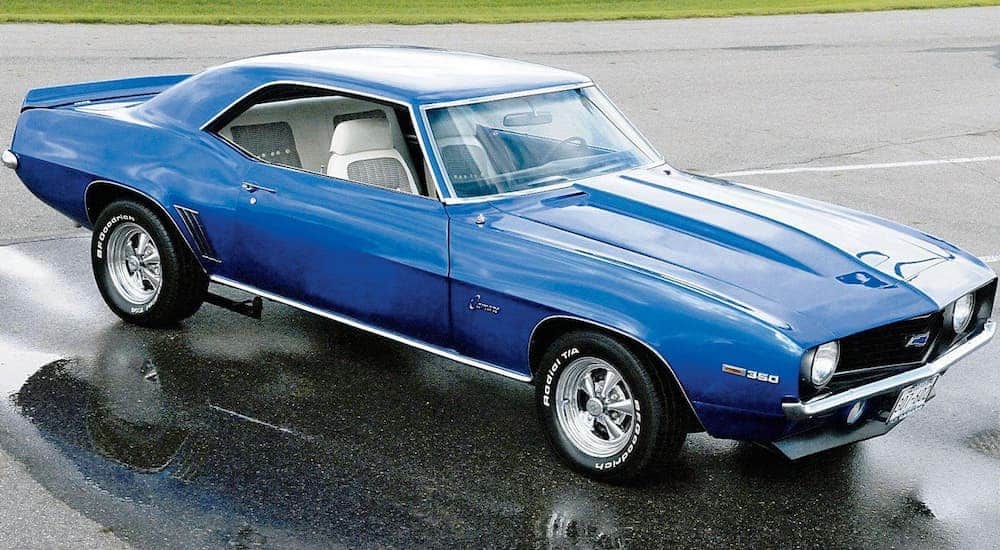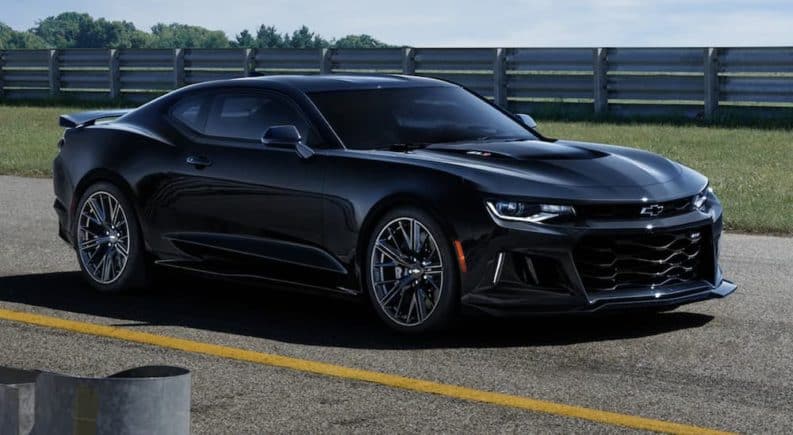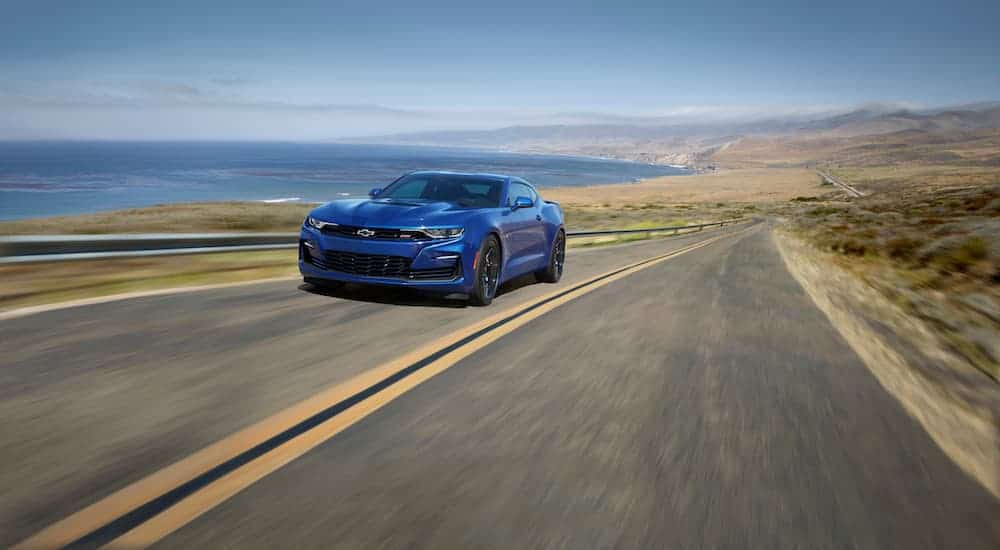The Chevy Camaro first came about as a direct competitor to the Ford Mustang. Originally code-named “Panther,” the Chevy Camaro first made its debut in the summer of 1966 for a 1967 model release. However, while the first generation Camaro rolled off the assembly line in 1967, it is the 1969 model that is most desired. This is when General Motors decided to push engine performance. When looking at the 1969 model and the 2019 Chevy Camaro and directly comparing 1969 vs 2019 you absolutely can see how the original Chevy pony car influenced the modern rendition. In some ways, it is the same, and yet the car has seen some sizable changes over the years, ranging everywhere from what’s under the hood to what’s inside the cabin. With a 2020 model about to hit the lot of a Chevy dealership near me, it’s time we look at this model to see how the modern version reflects the original.
The 1969 Trim Options
1969 came as the final model year of the Chevy Camaro’s first-generation, and with it, a number of improvements were made over the previous two years. It did keep the same hood, roof, and decklid, but the rest of the body was adjusted to help give it a smoother, less boxy appearance (if you look at the 1967 model you’ll notice there are more lines along the paneling, as if the body was built at slight angles to make a curve, instead of a smooth curve, such as around the wheel wells).
Most cars manufactured during the 1960s came with dozens of trim options. Just about every slight adjustment or option selected had a different moniker and name attached to it. However, most of these trim options were variations of four specific trim models. These are the base trim model, the RS, the SS, and the Z28.

The engine options for the 1969 model remained mostly the same as the 1967 offerings, with the standard trim using a straight-6 engine capable of producing 140 horsepower and 220 lb-ft of torque.
The RS trim package (short for Rally Sport), featured what is now a classic feature and especially desirable for car hunters: the hideaway headlamps. When the headlamps were activated, the grill in front of the lights would open, revealing the lights (while the hideaway lights did come standard on the RS, it could be added onto the SS and Z28).
The Super Sport (SS) Camaro was designed with performance in mind and took advantage of a vastly improved suspension system over the standard and RS trim packages. It also took advantage of a substantially better engine, ditching the straight-6 for a 5.4L V8 that was rated for 300 horsepower. It also made available an upgraded engine package with a 396 engine that upped the horsepower to 375.
The final trim model came in the form of the Z28. The Z28 is now legendary in the world of Camaro, and 1969 marked the very first year of its existence (which is one reason why the 1969 Camaro is often seen as more desirable than the two previous years). Unlike the RS and the SS, though, it did not have an indicator badge in the center of the grill. Instead, it featured a pair of racing stripes running down the hood. The Z28 was made as a consumer racing car and came standard with a 290 horsepower V8 engine, although with the additional racing trim features, the horsepower could be upped to 400 HP.
If you’re wondering, the average fuel economy for all 1969 Chevy Camaros combined was between 8 and 12 miles per gallon.
2019 Chevy Camaro Trim
Comparing the difference in mechanical specifications of cars with 50 years between build dates is tricky. While it is possible to look at the engine specs, it isn’t completely possible to make a direct comparison as technology has improved, so the engine size is no longer the end all be all of a pony car. However, it is, at the very least, interesting to look at the 1969 vs 2019 Chevy Camaro.
The base trim option of the 2019 Chevy Camaro actually features a smaller engine. Instead of using a straight-6 the 2019 Chevrolet Camaro utilized an I4 turbocharged engine. And while this four-cylinder engine is smaller than the base engine option in the 1969, it puts out 275 horsepower and 295 lb-ft of torque, which more than doubles the horsepower output. The smaller engine also allows for up to 20 miles per gallon in the city and 30 miles per gallon on the highway.
Much like the original, the 2019 Chevy Camaro (which is the sixth-generation Camaro) has a number of trim options, but it’s best for comparison purposes to look at the trim identifications. The 1SS trim uses a significantly larger engine than the base, upping it to a 6.2L V8, which also boosts the horsepower to 455 and the torque to 455 as well. All this and the fuel economy only dips to 16 in the city and 24 on the highway.
Now, the 2019 release did not include a Rally Car offering, but it did have a Z offering in the form of the ZL1. As the top-performing Camaro, this trim package included the same block V8 engine, but both the horsepower and torque are boosted to 650, which is a full 250 HP more than what the 1969 Z28 offered.
2020 Chevy Camaro
The 2020 Chevy Camaro remains true to the sixth generation design, making slight adjustments to the hood and nose of the vehicle (as well as a few tweaks here and there). The base still comes with the turbocharged I4 engine while it also offers a 3.6L V6 and a powerful V8. The V6 models offer an available 10-speed automatic transmission, which not only will make for a smoother transmission shift but improved fuel economy as well.
More specs and trim options will be made available as the 2020 Chevy Camaro begins shipping from its Lansing, Michigan assembly plant (with expected delivery dates coming soon).
Making Direct Comparisons Of All Chevy Camaros
Whether looking at a 2020 Chevy Camaro or considering the 1969 vs 2019 comparison, what’s right for one driver is not always going to be what’s right for the next. The modern renditions of the classic pony car are all vastly superior in terms of performance under the hood and technology inside the cabin. However, any car enthusiast will tell you it’s not always about specs. It’s about the way the car feels when you handle it. It’s the sound the engine makes when it comes to life. It’s about the smell of the vehicle.
There’s no loser when it comes to comparing Camaros. There will be some that absolutely love the I4 engine and the improved fuel efficiency, while there are others who get goosebumps whenever they hear the classic V8 roar awake when turning the key and the subtle shake stemming from the engine block. Ultimately, if you’re in the market for any kind of Camaro, you need to consider exactly what interests you, and make sure to search for a “Chevy dealer near me” in your search engine, to see whether a classic or a modern 2020 Chevy Camaro is right for you.





